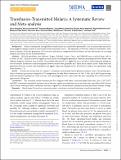Files in this item
Transfusion-transmitted malaria : a systematic review and meta-analysis
Item metadata
| dc.contributor.author | Ahmadpour, Ehsan | |
| dc.contributor.author | Foroutan-Rad, Masoud | |
| dc.contributor.author | Majidiani, Hamidreza | |
| dc.contributor.author | Moghaddam, Sirous Mehrani | |
| dc.contributor.author | Hatam-Nahavandi, Kareem | |
| dc.contributor.author | Hosseini, Seyed-Abdollah | |
| dc.contributor.author | Rahimi, Mohammad Taghi | |
| dc.contributor.author | Barac, Aleksandra | |
| dc.contributor.author | Rubino, Salvatore | |
| dc.contributor.author | Zarean, Mehdi | |
| dc.contributor.author | Mathioudakis, Alexander G | |
| dc.contributor.author | Cevik, Muge | |
| dc.date.accessioned | 2019-07-31T09:30:02Z | |
| dc.date.available | 2019-07-31T09:30:02Z | |
| dc.date.issued | 2019-07 | |
| dc.identifier | 260335129 | |
| dc.identifier | 046992a0-ed06-4d39-96c5-af6dfc2b0368 | |
| dc.identifier | 31334300 | |
| dc.identifier | 85073259703 | |
| dc.identifier | 000481501400032 | |
| dc.identifier.citation | Ahmadpour , E , Foroutan-Rad , M , Majidiani , H , Moghaddam , S M , Hatam-Nahavandi , K , Hosseini , S-A , Rahimi , M T , Barac , A , Rubino , S , Zarean , M , Mathioudakis , A G & Cevik , M 2019 , ' Transfusion-transmitted malaria : a systematic review and meta-analysis ' , Open Forum Infectious Diseases , vol. 6 , no. 7 , ofz283 . https://doi.org/10.1093/ofid/ofz283 | en |
| dc.identifier.issn | 2328-8957 | |
| dc.identifier.other | PubMedCentral: PMC6634438 | |
| dc.identifier.other | ORCID: /0000-0003-1133-3874/work/60427709 | |
| dc.identifier.uri | https://hdl.handle.net/10023/18210 | |
| dc.description.abstract | Background : Malaria transmission through blood transfusion is an accidental but preventable cause of malaria infection and is increasingly becoming a matter of concern for blood transfusion services. This systematic review was conducted to provide a summary of evidence about the prevalence of Plasmodium infection in asymptomatic blood donors and the effectiveness of screening methods used based on the available literature. Methods : PRISMA guidelines were followed. Scopus, PubMed, Science Direct, and EMBASE were searched from 1982 to October 10, 2017. All peer-reviewed original research articles describing the prevalence of malaria parasitemia in blood donors with different diagnostic methods were included. The random-effects model was applied to assess the effects of heterogeneity among the selected studies. Incoherence and heterogeneity between studies were quantified by I2 index and Cochran's Q test. Publication and population bias was assessed with funnel plots and Egger's regression asymmetry test. All statistical analyses were performed using Stata (version 2.7.2). Results : Seventy-one studies from 21 countries, 5 continents, were included in the present systematic review. The median prevalence of malaria parasitemia among 984 975 asymptomatic healthy blood donors was 10.54%, 5.36%, and 0.38% by microscopy, molecular methods (polymerase chain reaction), and rapid diagnostic tests, respectively. The most commonly detected Plasmodium species was P. falciparum. Conclusions : This systematic review demonstrates that compared with other transfusion-linked infections, that is, HIV, HCV, and HBV, transfusion-transmitted malaria is one of the most significant transfusion-associated infections especially in Sub-Saharan Africa. Future work must aim to understand the clinical significance of transfusion-transmitted malaria in malaria-endemic settings. | |
| dc.format.extent | 8 | |
| dc.format.extent | 458758 | |
| dc.language.iso | eng | |
| dc.relation.ispartof | Open Forum Infectious Diseases | en |
| dc.subject | Blood donor | en |
| dc.subject | Plasmodium | en |
| dc.subject | Systematic review | en |
| dc.subject | Transfusion-associated infections | en |
| dc.subject | Transfusion medicine | en |
| dc.subject | QR180 Immunology | en |
| dc.subject | T-NDAS | en |
| dc.subject | SDG 3 - Good Health and Well-being | en |
| dc.subject.lcc | QR180 | en |
| dc.title | Transfusion-transmitted malaria : a systematic review and meta-analysis | en |
| dc.type | Journal article | en |
| dc.contributor.institution | University of St Andrews. School of Medicine | en |
| dc.identifier.doi | 10.1093/ofid/ofz283 | |
| dc.description.status | Peer reviewed | en |
This item appears in the following Collection(s)
Items in the St Andrews Research Repository are protected by copyright, with all rights reserved, unless otherwise indicated.

